- Home
- War in the Middle East
- Insight into "Prosperity Guardian" Operation in Six Key Points

©(AFP)
Led by the United States, the "Prosperity Guardian" operation, which involves approximately a dozen countries, aims to protect the Red Sea from attacks launched by the Houthis based in Yemen. Here are six key points outlining the primary features of this deployment.
On Wednesday, December 27, two of the world's major shipping companies, the French CMA-CGM and the Danish Maersk, announced the resumption of transit through the Suez Canal via the Red Sea.
This move comes after both companies, along with several other global maritime giants, had initially announced in mid-December the suspension of their vessels' passage through this crucial trade route due to the increasing attacks carried out by the Houthi rebels based in western Yemen.
[readmore url="https://thisisbeirut.com.lb/lebanon/202909"]
The key factor driving this resurgence can be summed up in three words: "Prosperity Guardian" operation. Behind this name lies a coalition of about a dozen countries, primarily Western and spearheaded by the United States. The mission's objective is to establish a defense mechanism against attacks orchestrated by the Iran-backed group.
Since the October 7th attack carried out by Hamas against Israel, the Houthis have been consistently launching attacks on Israeli territory using long-range missiles and drones.
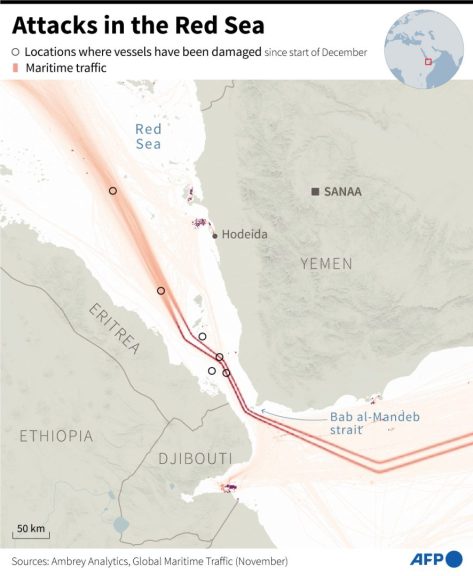
Subsequently, the pro-Iranian group extended its operations to target ships heading to or associated with Israel, passing through the strategic Bab el-Mandeb strait. Over 12% of global maritime freight and 40% of Asia's trade with Europe pass through this region, which separates the Arabian Peninsula from Africa, emphasizing its critical importance.
On November 17th, a helicopter-borne commando intercepted the Galaxy Leader container ship and redirected it to the port of Hodeidah, which they control. Since then, approximately fifteen ships have been subjected to drone and missile attacks, leading to damage in some cases.
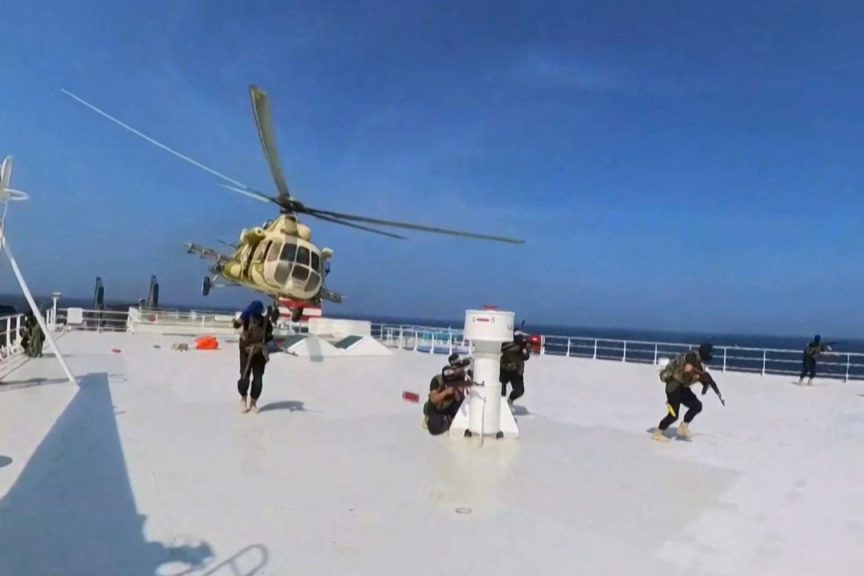 A grab from handout footage released by Houthi Ansarullah Media Centre on November 19, 2023, reportedly shows members of the rebel group during the capture of Israel-linked cargo Galaxy Leader in the Red Sea. (ANSARULLAH MEDIA CENTRE, AFP)
A grab from handout footage released by Houthi Ansarullah Media Centre on November 19, 2023, reportedly shows members of the rebel group during the capture of Israel-linked cargo Galaxy Leader in the Red Sea. (ANSARULLAH MEDIA CENTRE, AFP)
In response, major global shipping companies have sequentially announced their decision to abandon this communication route in favor of circumnavigating Africa. While this option enhances security, it notably extends the transit time by two weeks for ships destined for Europe.
The operation was announced by U.S. Secretary of Defense Lloyd Austin on December 18. He justifies such a deployment, citing "the recent escalation of irresponsible attacks by the Houthis from Yemen threatens the free flow of commerce, endangers the lives of innocent sailors, and violates international law."
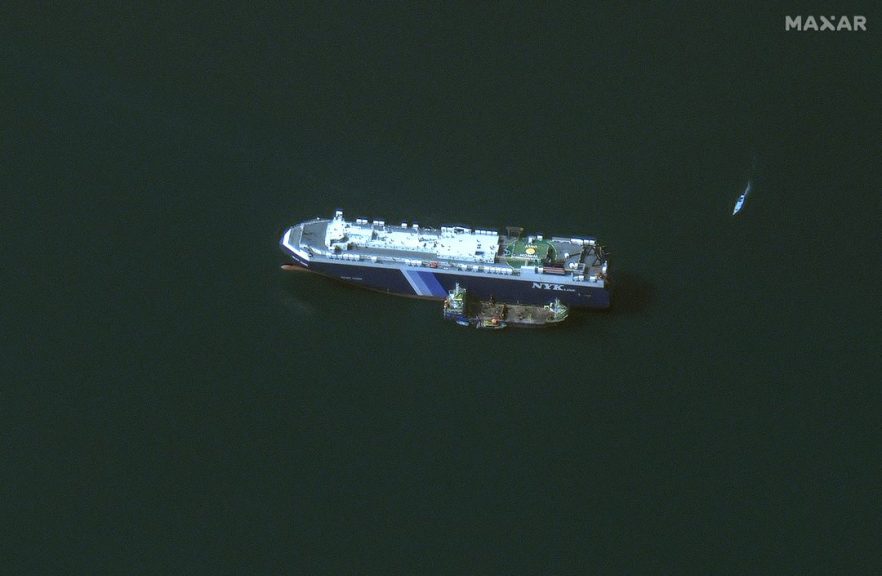 The Galaxy Leader cargo ship, under Houthi control near Hodeida, Yemen, on November 28. (Maxar Technologies, AFP)
The Galaxy Leader cargo ship, under Houthi control near Hodeida, Yemen, on November 28. (Maxar Technologies, AFP)
Mr. Austin specified that 10 countries are part of this coalition: France, the United Kingdom, Bahrain, Canada, Italy, the Netherlands, Norway, Spain, and the Seychelles.
Despite being directly affected, Israel is not officially part of it. The Defense Secretary also announced that several Arab countries, who wished to remain anonymous, were supporting the operation.
Greece later announced its intention to join this coalition, confirming the dispatch of a ship, while Australia stated it would send military personnel.
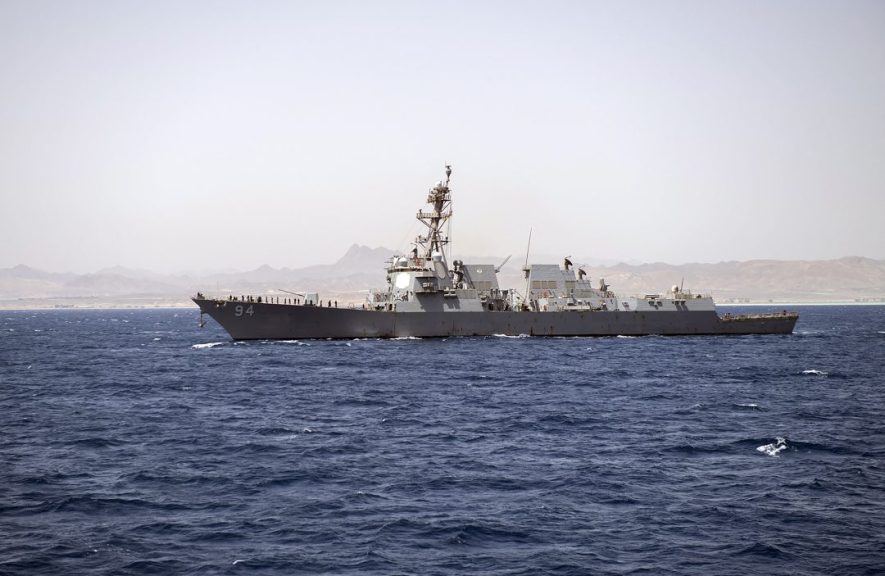 A photo from June 2020 shows a U.S. destroyer leaving Egyptian territorial waters in July 2019. (William HARDY, AFP)
A photo from June 2020 shows a U.S. destroyer leaving Egyptian territorial waters in July 2019. (William HARDY, AFP)
Additionally, some other countries already involved in the operation have declared that they will send only personnel, mainly due to a lack of available resources. This includes Canada, Norway, the Netherlands, Denmark, and the Seychelles.
On the contrary, some countries mentioned by Mr. Lloyd have stated that they will not take part in the operation. Firstly, Spain clarified on Saturday, December 23, that it prefers a mission exclusively under the auspices of the European Union. Spain currently has a frigate in the region as part of the European anti-piracy operation Atalante.
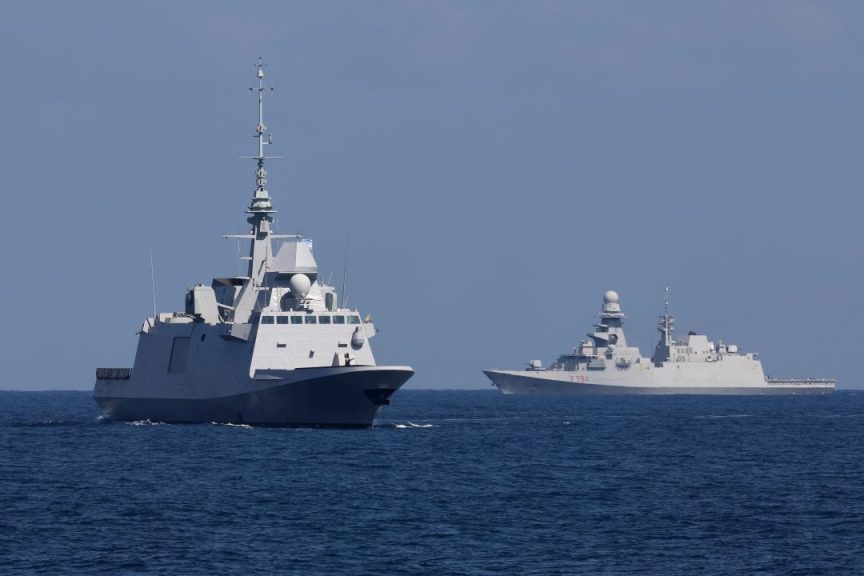 The French frigate Languedoc and the Italian frigate Alpino in the Mediterranean on March 27, 2023. (Jack GUEZ, AFP)
The French frigate Languedoc and the Italian frigate Alpino in the Mediterranean on March 27, 2023. (Jack GUEZ, AFP)
However, this is also the case for Paris, whose frigate Languedoc gained recognition on December 9 and 11 by successfully intercepting Houthi drones.
While France asserted its commitment to regional security through its pre-existing assets in the area, it opted to retain command over them. The same applies to Italy, which cited similar reasons for not participating.
The "Prosperity Guardian" operation under the command of Combined Task Force 153, a multinational unit led by the United States and established in 2022.
According to the Pentagon, the core of this unit comprises at least five combat ships (three American, one British, and one Greek), complemented by various aircraft, including fighter planes, patrol planes, helicopters, and drones. The temporary involvement of the USS Eisenhower aircraft carrier is also a notable aspect.
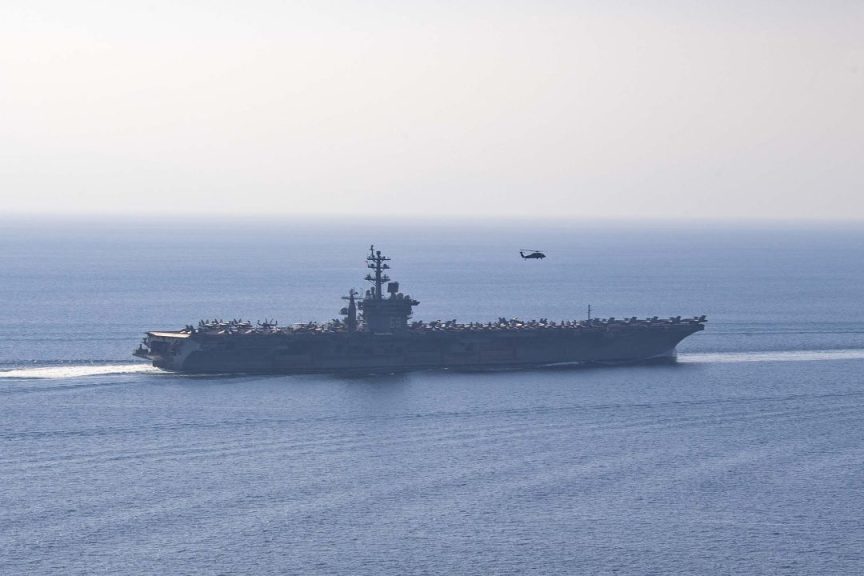 In this photo obtained from the U.S. Department of Defense, the USS Dwight D. Eisenhower aircraft carrier of the U.S. Navy crosses the Strait of Hormuz on November 26, 2023. (Merissa DALEY, U.S. Department of Defense, AFP)
In this photo obtained from the U.S. Department of Defense, the USS Dwight D. Eisenhower aircraft carrier of the U.S. Navy crosses the Strait of Hormuz on November 26, 2023. (Merissa DALEY, U.S. Department of Defense, AFP)
In this context, the primary goal of "Prosperity Guardian" is to establish permanent protection for ships in transit. This involves deploying specialized anti-aircraft defenses against the vectors used by the Houthis, provided by the combat ships positioned in the region.
The thwarted Houthi attacks by the French and American navies since October 7 have highlighted the effectiveness of deploying such defense measures. However, some analysts express concerns regarding the cost disparity between the means employed by the Houthis and those at the disposal of the coalition.
Indeed, the average cost of drones used by the pro-Iranian group would easily fall below $100,000. According to the Center for Strategic and International Studies, even the most basic models would cost less than $2,000. The Shahed-136 model, known for its use in Ukraine and a part of the Houthi arsenal, is estimated to be priced around $20,000.
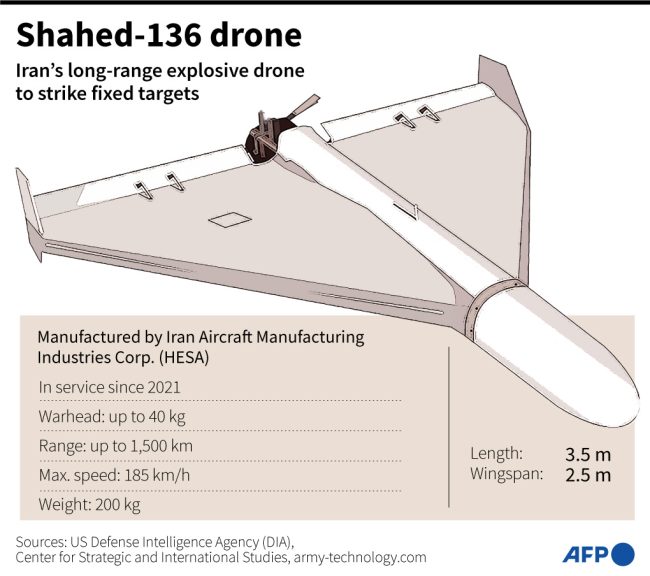 Graphic on the Iranian-made Shahed-136 explosive drone used by the Russian army in Ukraine
Graphic on the Iranian-made Shahed-136 explosive drone used by the Russian army in Ukraine
- AFP / AFP / JEAN-MICHEL CORNU
In contrast, the anti-aircraft defense missiles employed on Western ships carry a substantially higher cost, averaging around $2 million. This pronounced cost disparity between the defensive measures and the attack vectors has raised concerns. A representative from the U.S. Department of Defense notably acknowledged, "The cost balance is not in our favor."
However, these cost considerations must be viewed in perspective with the potential impact on global trade that a prolonged disruption of traffic through the Bab el-Mandeb could entail. The suspension of transit by major maritime freight companies, even for a brief period, has notably led to an increase in fuel prices, insurance premiums, and transit costs.
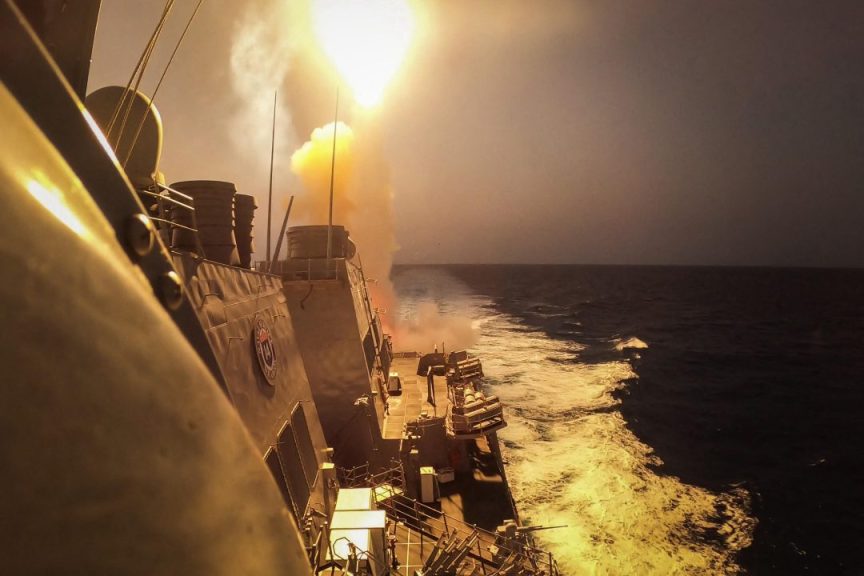 This handout picture courtesy of the US Navy taken on October 19, 2023 shows the Arleigh Burke-class guided-missile destroyer USS Carney (DDG 64) defeating a combination of Houthi missiles and unmanned aerial vehicles in the Red Sea. (Aaron LAU, US NAVY, AFP)
This handout picture courtesy of the US Navy taken on October 19, 2023 shows the Arleigh Burke-class guided-missile destroyer USS Carney (DDG 64) defeating a combination of Houthi missiles and unmanned aerial vehicles in the Red Sea. (Aaron LAU, US NAVY, AFP)
This price surge inevitably translates into higher consumer prices. The primary losers in such a situation would be European countries and those in the Mediterranean basin.
In this context, the use of missiles that may cost up to two million dollars appears immediately more relevant. Especially when considering that any Western military intervention aimed at curbing the Houthis' activities would fundamentally incur higher costs, not to mention the potentially catastrophic geopolitical consequences it could bring about.
On Wednesday, December 27, two of the world's major shipping companies, the French CMA-CGM and the Danish Maersk, announced the resumption of transit through the Suez Canal via the Red Sea.
This move comes after both companies, along with several other global maritime giants, had initially announced in mid-December the suspension of their vessels' passage through this crucial trade route due to the increasing attacks carried out by the Houthi rebels based in western Yemen.
[readmore url="https://thisisbeirut.com.lb/lebanon/202909"]
The key factor driving this resurgence can be summed up in three words: "Prosperity Guardian" operation. Behind this name lies a coalition of about a dozen countries, primarily Western and spearheaded by the United States. The mission's objective is to establish a defense mechanism against attacks orchestrated by the Iran-backed group.
Why Such an Operation?
Since the October 7th attack carried out by Hamas against Israel, the Houthis have been consistently launching attacks on Israeli territory using long-range missiles and drones.

Subsequently, the pro-Iranian group extended its operations to target ships heading to or associated with Israel, passing through the strategic Bab el-Mandeb strait. Over 12% of global maritime freight and 40% of Asia's trade with Europe pass through this region, which separates the Arabian Peninsula from Africa, emphasizing its critical importance.
On November 17th, a helicopter-borne commando intercepted the Galaxy Leader container ship and redirected it to the port of Hodeidah, which they control. Since then, approximately fifteen ships have been subjected to drone and missile attacks, leading to damage in some cases.
 A grab from handout footage released by Houthi Ansarullah Media Centre on November 19, 2023, reportedly shows members of the rebel group during the capture of Israel-linked cargo Galaxy Leader in the Red Sea. (ANSARULLAH MEDIA CENTRE, AFP)
A grab from handout footage released by Houthi Ansarullah Media Centre on November 19, 2023, reportedly shows members of the rebel group during the capture of Israel-linked cargo Galaxy Leader in the Red Sea. (ANSARULLAH MEDIA CENTRE, AFP)In response, major global shipping companies have sequentially announced their decision to abandon this communication route in favor of circumnavigating Africa. While this option enhances security, it notably extends the transit time by two weeks for ships destined for Europe.
Who Is Participating?
The operation was announced by U.S. Secretary of Defense Lloyd Austin on December 18. He justifies such a deployment, citing "the recent escalation of irresponsible attacks by the Houthis from Yemen threatens the free flow of commerce, endangers the lives of innocent sailors, and violates international law."
 The Galaxy Leader cargo ship, under Houthi control near Hodeida, Yemen, on November 28. (Maxar Technologies, AFP)
The Galaxy Leader cargo ship, under Houthi control near Hodeida, Yemen, on November 28. (Maxar Technologies, AFP)Mr. Austin specified that 10 countries are part of this coalition: France, the United Kingdom, Bahrain, Canada, Italy, the Netherlands, Norway, Spain, and the Seychelles.
Despite being directly affected, Israel is not officially part of it. The Defense Secretary also announced that several Arab countries, who wished to remain anonymous, were supporting the operation.
Greece later announced its intention to join this coalition, confirming the dispatch of a ship, while Australia stated it would send military personnel.
 A photo from June 2020 shows a U.S. destroyer leaving Egyptian territorial waters in July 2019. (William HARDY, AFP)
A photo from June 2020 shows a U.S. destroyer leaving Egyptian territorial waters in July 2019. (William HARDY, AFP)Additionally, some other countries already involved in the operation have declared that they will send only personnel, mainly due to a lack of available resources. This includes Canada, Norway, the Netherlands, Denmark, and the Seychelles.
Who Is Not Participating?
On the contrary, some countries mentioned by Mr. Lloyd have stated that they will not take part in the operation. Firstly, Spain clarified on Saturday, December 23, that it prefers a mission exclusively under the auspices of the European Union. Spain currently has a frigate in the region as part of the European anti-piracy operation Atalante.
 The French frigate Languedoc and the Italian frigate Alpino in the Mediterranean on March 27, 2023. (Jack GUEZ, AFP)
The French frigate Languedoc and the Italian frigate Alpino in the Mediterranean on March 27, 2023. (Jack GUEZ, AFP)However, this is also the case for Paris, whose frigate Languedoc gained recognition on December 9 and 11 by successfully intercepting Houthi drones.
While France asserted its commitment to regional security through its pre-existing assets in the area, it opted to retain command over them. The same applies to Italy, which cited similar reasons for not participating.
What Personnel and Assets Are Involved?
The "Prosperity Guardian" operation under the command of Combined Task Force 153, a multinational unit led by the United States and established in 2022.
According to the Pentagon, the core of this unit comprises at least five combat ships (three American, one British, and one Greek), complemented by various aircraft, including fighter planes, patrol planes, helicopters, and drones. The temporary involvement of the USS Eisenhower aircraft carrier is also a notable aspect.
 In this photo obtained from the U.S. Department of Defense, the USS Dwight D. Eisenhower aircraft carrier of the U.S. Navy crosses the Strait of Hormuz on November 26, 2023. (Merissa DALEY, U.S. Department of Defense, AFP)
In this photo obtained from the U.S. Department of Defense, the USS Dwight D. Eisenhower aircraft carrier of the U.S. Navy crosses the Strait of Hormuz on November 26, 2023. (Merissa DALEY, U.S. Department of Defense, AFP)In this context, the primary goal of "Prosperity Guardian" is to establish permanent protection for ships in transit. This involves deploying specialized anti-aircraft defenses against the vectors used by the Houthis, provided by the combat ships positioned in the region.
Costly Defense Measures
The thwarted Houthi attacks by the French and American navies since October 7 have highlighted the effectiveness of deploying such defense measures. However, some analysts express concerns regarding the cost disparity between the means employed by the Houthis and those at the disposal of the coalition.
Indeed, the average cost of drones used by the pro-Iranian group would easily fall below $100,000. According to the Center for Strategic and International Studies, even the most basic models would cost less than $2,000. The Shahed-136 model, known for its use in Ukraine and a part of the Houthi arsenal, is estimated to be priced around $20,000.
 Graphic on the Iranian-made Shahed-136 explosive drone used by the Russian army in Ukraine
Graphic on the Iranian-made Shahed-136 explosive drone used by the Russian army in Ukraine- AFP / AFP / JEAN-MICHEL CORNU
In contrast, the anti-aircraft defense missiles employed on Western ships carry a substantially higher cost, averaging around $2 million. This pronounced cost disparity between the defensive measures and the attack vectors has raised concerns. A representative from the U.S. Department of Defense notably acknowledged, "The cost balance is not in our favor."
Yet, Relevant Solutions
However, these cost considerations must be viewed in perspective with the potential impact on global trade that a prolonged disruption of traffic through the Bab el-Mandeb could entail. The suspension of transit by major maritime freight companies, even for a brief period, has notably led to an increase in fuel prices, insurance premiums, and transit costs.
 This handout picture courtesy of the US Navy taken on October 19, 2023 shows the Arleigh Burke-class guided-missile destroyer USS Carney (DDG 64) defeating a combination of Houthi missiles and unmanned aerial vehicles in the Red Sea. (Aaron LAU, US NAVY, AFP)
This handout picture courtesy of the US Navy taken on October 19, 2023 shows the Arleigh Burke-class guided-missile destroyer USS Carney (DDG 64) defeating a combination of Houthi missiles and unmanned aerial vehicles in the Red Sea. (Aaron LAU, US NAVY, AFP)This price surge inevitably translates into higher consumer prices. The primary losers in such a situation would be European countries and those in the Mediterranean basin.
In this context, the use of missiles that may cost up to two million dollars appears immediately more relevant. Especially when considering that any Western military intervention aimed at curbing the Houthis' activities would fundamentally incur higher costs, not to mention the potentially catastrophic geopolitical consequences it could bring about.

Comments